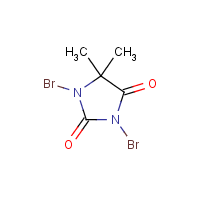1,3-Dibromo-5,5-dimethylhydantoin
Agent Name
1,3-Dibromo-5,5-dimethylhydantoin
CAS Number
77-48-5
Formula
C5-H6-Br2-N2-O2
Major Category
Other Uses

Synonyms
1,3-Dibromo-5,5-dimethyl-2,4-imidazolidinedione; 5,5-Dimethyl-1,3-dibromohydantoin; Dibromantin; Dibromantine; N,N'-Dibromodimethylhydantoin; Take Charge Orange; 2,4-Imidazolidinedione, 1,3-dibromo-5,5-dimethyl-; Hydantoin, 1,3-dibromo-5,5-dimethyl-; [ChemIDplus]
Category
Biocides/Disinfectants
Description
Light yellow powder; [Aldrich MSDS]
Sources/Uses
Halohydantoins: Used as disinfectants in swimming pools, hot tubs, toilet bowls, and industrial systems (cooling water, pulp and paper, wastewater, and sewage); Also used as slimicide for paper/paperboard for food contact; [Reference #1]
Comments
Evidence of thyroid hypofunction in repeated dose study of rats; [RTECS] Corrosive to skin; Not sensitizing to guinea pigs; Halohydantoins: The persistent metabolites, 5,5-Dimethylhydantoin (DMH) and 5-Ethyl-5-methylhydantoin (EMH), are used for developing toxicity data for this group of compounds; Quickly decomposed by water forming hypochlorous or hypobromous acid (the true biocidal agents) and DMH or EMH; DMH/EMH: Sub-chronic, developmental, reproductive, and chronic toxicity animal studies have shown non-specific toxicity at high doses (no evidence of carcinogenicity, reproductive or developmental toxicity, and limited evidence of mutagenicity); [Reference #1] An oxidizer that can intensify fire; Causes burns; Inhalation may cause corrosive injuries to upper respiratory tract and lungs; Toxic by ingestion; [Aldrich MSDS] See "1,3-Dichloro-5,5-dimethylhydantoin."
Reference Link #1
Biomedical References
Exposure Assessment
Lethal Concentration
LC50 (rat) = 510 - 2,020 mg/m3
Adverse Effects
Dermatotoxin
Skin burns
Diseases, Processes, and Activities Linked to This Agent
Processes
Industrial Processes with risk of exposure: